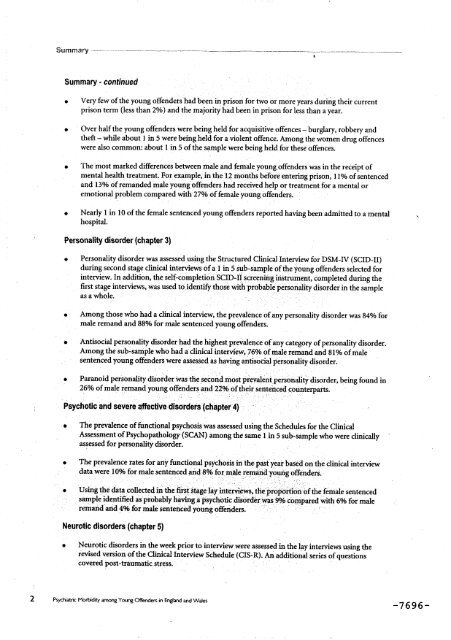Neurotic disorders
Neurotic disorders
Neurotic disorders
Create successful ePaper yourself
Turn your PDF publications into a flip-book with our unique Google optimized e-Paper software.
Summary ...............................................................................................................................................................<br />
m<br />
Summary - continued<br />
• Very few of the young offenders had been in prison for two or more years during their current<br />
prison term (less than 2%) and the majority had been in prison for less than a year.<br />
• Over half the young offenders were being held for acquisitive offences - burglary, robbery and<br />
theft - while about 1 in 5 were being held for a violent offence. Among the women drug offences<br />
were also common: about 1 in 5 of the sample were being held for these offences.<br />
• The most marked differences between male and female young offenders was in the receipt of<br />
mental health treatment. For example, in the 12 months before entering prison, 11% of sentenced<br />
and 13% of remanded male young offenders had received help or treatment for a mental or<br />
emotional problem compared with 27%of female young offenders.<br />
• Nearly 1 in I0 of the female sentenced young offenders reported having been admitted to a mental<br />
hospital.<br />
Personality disorder (chapter 3)<br />
• Personality disorder was assessed using the Structured Clinical Interview for DSM-IV (SCID-II)<br />
during second stage clinical interviews of a 1 in 5 sUb-sample of the young offenders selected for<br />
interview. In addition, the Self-completion SCID-II screening instrument, completed during the<br />
first stage interviews, was used to identify those with probable personality disorder in the sample<br />
as a whole.<br />
• Among those who had a clinical interview, the prevalence of any personality disorder was 84% for<br />
male remand and 88% for male sentenced young offenders.<br />
• Antisocial personality disorder had the highest prevalence of any category of personality disorder.<br />
Among the sub-sample who had a clinical interview, 76O/ of male remand and 81% of male<br />
sentenced young offenders •were assessed as having antisocial personality disorder.<br />
• Paranoid personality disorder Was the second most prevalentpersonality disorder, being found in<br />
26% of male remand young offenders and 22% of their sentenced counterparts.<br />
- . • -"<br />
Psychotic and severe affective <strong>disorders</strong> (chapter:4)<br />
• The prevalence of functional psychosis was assessed using the Schedules for the Clinical<br />
Assessment of Psychopathology (SCAN) among the same I in 5 sub-sample who were clinically<br />
assessed for personality disorder.<br />
• The prevalence rates for any functional psychosis in thepas t year based on the clinical interview<br />
data were 10% for male sentenced and 8% for male rema_dyoung offenders.<br />
• Using the dat a collected in the first _tage lay interviews, thepropo/fi6n 0f the female sentenced<br />
sample identified as probablyhavinga psych0tic dis0rderwaS 9% c0mpared with 6% for male<br />
remand and4% for male Sentenced young offenders.<br />
<strong>Neurotic</strong> <strong>disorders</strong> (chapter 5)<br />
- ..:<br />
• <strong>Neurotic</strong> <strong>disorders</strong> in the week prior to interview were assessed in the lay interviews using the<br />
revised version of the Clinical Interview Schedule (CIS-R). An additional series of questions<br />
covered post-traumatic stress.<br />
2 Psychiatric Morbidity among Young Offenders in England and Wales -- 7 6 9 6 -

















